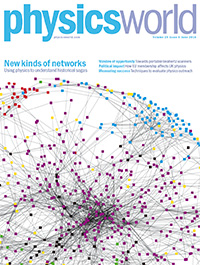 By Matin Durrani
By Matin Durrani
Physicists can turn their hands to some unusual subjects. But in the June 2016 issue of Physics World magazine – now live in the Physics World app for mobile and desktop – we reveal the unexpected link between physics and ancient Icelandic sagas. If you don’t believe us, check our cover feature out.
Meanwhile, with the UK referendum on its membership of the European Union (EU) looming, we examine what impact the EU has on UK physics – and how remaining in or leaving the EU could affect the country’s science.
Don’t miss either our review of the new film The Man Who Knew Infinity, while our forum section this month has advice from Barry Sanders of the University of Calgary for how best to collaborate with scientists in China. There’s also a great interview with the new president of the US National Academy of Sciences Marcia McNutt.
If you’re a member of the Institute of Physics (IOP), you can now enjoy immediate access to the new issue with the digital edition of the magazine in your web browser or on any iOS or Android mobile device (just download the Physics World app from the App Store or Google Play). If you’re not yet in the IOP, you can join as an IOPimember for just £15, €20 or $25 a year to get full access to Physics World digital.
For the record, here’s a run-down of what else is in the issue.
• UK physics faces EU choice – Simon Perks looks at what this month’s European Union referendum could mean for physics
• European questions – Matin Durrani on how the UK referendum on EU membership will shape the country for years to come
• Building a relationship with China – Barry Sanders says that successful collaboration with researchers in China can be fostered by being sensitive to cultural norms
• Guarding integrity – Robert P Crease talks to Marcia McNutt, who takes over as president of the US National Academy of Sciences next month
• Maths meets myths – Scholars have long debated whether the Sagas of Icelanders – ancient narratives set in the Viking Age – are fact or fiction. Ralph Kenna and Pádraig Mac Carron analysed the structures of the saga societies to shed light on this question
• It’s time for terahertz – The quest is on to make terahertz sources that are small, portable and capable of operating at room temperature. Such a breakthrough could lead to advances in everything from cancer screening to astronomy, reports Keith Cooper
• Evaluating success – Outreach and public engagement are all the rage in physics. But how do we know what works and what does not? Simon Perks explores the dark art of evaluation
• A space–time operetta – Mark Hannam reviews Black Hole Blues and Other Songs from Outer Space by Janna Levin
• China’s tunnel vision – Richard de Grijs reviews From the Great Wall to the Great Collider: China and the Quest to Uncover the Inner Workings of the Universe by Steve Nadis and Shing-Tung Yau
• Under sea, over land – Acoustic scientist Daniel Finfer describes life at Silixa, a start-up firm that provides fibre-optic sensing technologies to the oil and gas industry
• Once a physicist – Jon Palfreman is a science journalist and author of Brain Storms: the Race to Unlock the Mysteries of Parkinson’s Disease
• What we don’t know about physics – Peter Kenny wonders just how sparse his physics knowledge really is
Guidelines
Show/hide formatting guidelines
this text was deletedwhere people live in harmony with nature and animals</q>
Some text